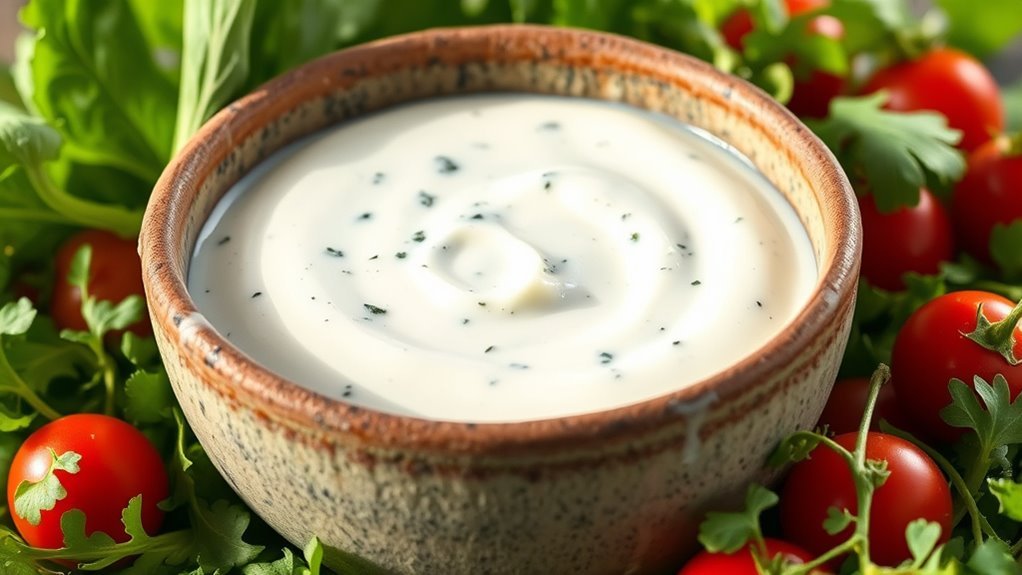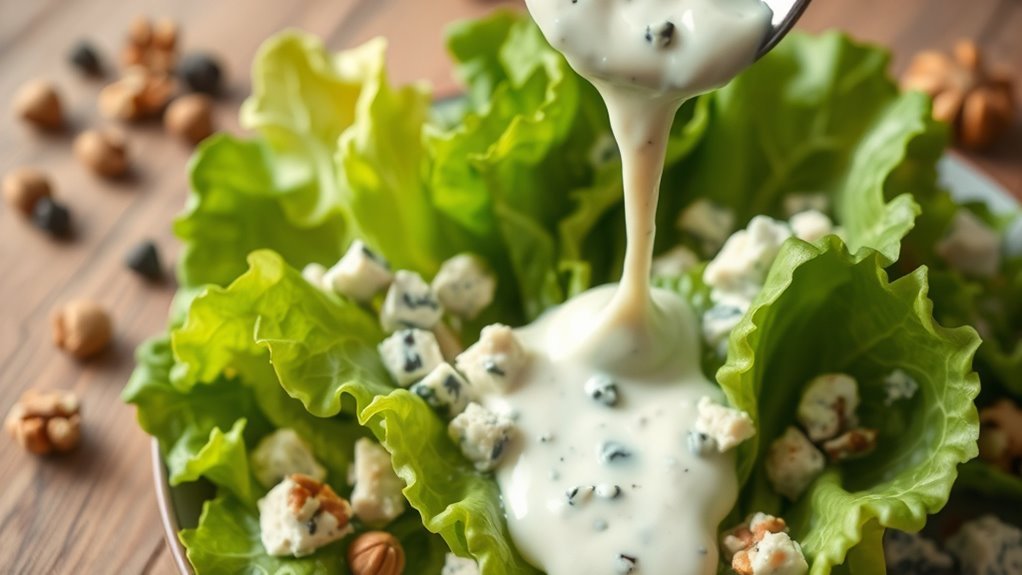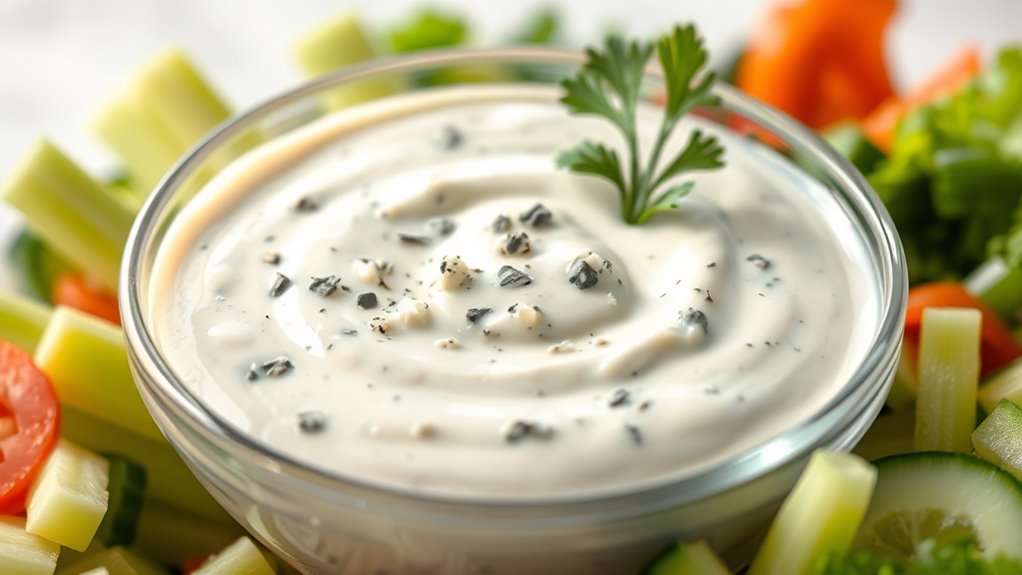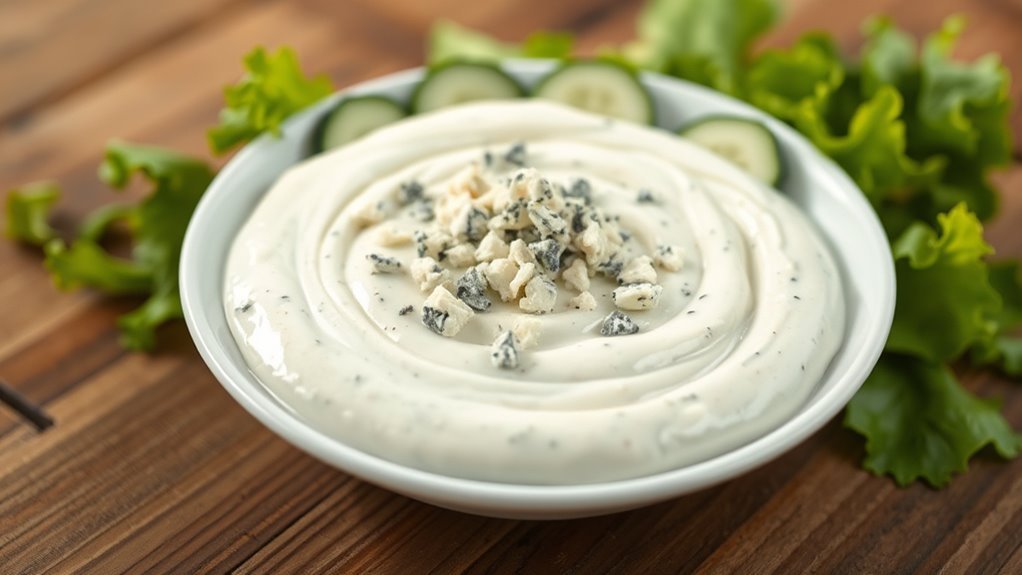Yes, blue cheese dressing is keto-friendly! With a low carbohydrate content of about 1-3 grams per serving and a high fat profile, it fits perfectly into your keto diet. Made primarily from blue cheese, mayonnaise, and sour cream, it provides healthy fats while avoiding sugars. Additionally, homemade versions can be cleaner and free from unwanted additives. If you’re curious about how to best incorporate it into your meals, there’s more to explore.
Understanding the Keto Diet and Its Requirements

When considering the keto diet, it’s crucial to understand its core principles and nutritional requirements. The keto diet primarily focuses on drastically reducing carbohydrates while increasing healthy fats. This shift encourages your body to enter ketosis, a state where it burns fat for energy instead of carbs. To successfully follow the keto principles, you’ll need to adhere to specific dietary restrictions, typically aiming for a macronutrient ratio of about 70% fats, 25% protein, and only 5% carbohydrates. This means you’ll be avoiding high-carb foods like grains, sugars, and certain fruits, while embracing low-carb vegetables, nuts, and healthy oils. By understanding these requirements, you can make informed choices that align with your goals for energy and freedom in your dietary journey.
The Ingredients of Blue Cheese Dressing

For those following the keto diet, understanding the ingredients in blue cheese dressing is important to determine if it fits within your dietary guidelines. Typically, blue cheese dressing consists of blue cheese, mayonnaise, sour cream, and vinegar. These ingredients can vary considerably, leading to different dressing variations.
While blue cheese provides a rich flavor and essential fats, the mayo and sour cream contribute creaminess and additional fats. However, it’s vital to check for added sugars or thickeners in commercial varieties, as these can affect your carb intake. If you’re making it at home, you can control the ingredients, ensuring they align with your keto goals. Ultimately, choose high-quality ingredients to enjoy the full benefits of this delicious dressing.
Carb Content in Blue Cheese Dressing

When considering the carb content in blue cheese dressing, it’s important to look at the nutritional breakdown of both homemade and store-bought versions. Generally, homemade dressings can have fewer carbs due to the absence of preservatives and added sugars. In contrast, some store-bought options may include additional ingredients that increase their carbohydrate content, making it vital to read labels carefully.
Nutritional Breakdown Overview
While many dressings can be high in carbohydrates, blue cheese dressing typically stands out as a keto-friendly option. Its nutritional value is generally favorable for those following a low-carb diet. A standard serving contains around 1-3 grams of carbs, making it much lower than many other dressing types, like ranch or honey mustard. The primary ingredients—blue cheese, cream, and vinegar—contribute healthy fats while keeping carbs minimal. Additionally, this dressing is rich in flavor, allowing you to enjoy your meals without sacrificing taste. When you opt for blue cheese dressing, you’re not only adding a bold kick to your dishes but also maintaining your keto lifestyle effectively. It’s a versatile choice that aligns well with your dietary goals.
Comparing Homemade vs. Store-bought
Homemade blue cheese dressing often allows for better control over carb content compared to store-bought varieties. By making it yourself, you can choose low-carb ingredients and avoid added sugars often found in commercial products. Here’s a quick comparison:
| Type | Carb Content (per 2 tbsp) | Popular Blue Cheese Varieties |
|---|---|---|
| Homemade | 1-2g | Roquefort, Gorgonzola |
| Store-bought | 2-5g | Danish Blue, Maytag |
| Dressing Alternative | 0-1g | Ranch, Caesar |
| Light Options | 1-3g | Reduced-fat blue cheese |
| Specialty Flavors | 3-6g | Herb-infused blue cheese |
Choosing homemade options or low-carb dressing alternatives can help keep you on track with your keto goals while enjoying the rich flavors of blue cheese.
Nutritional Benefits of Blue Cheese
Although blue cheese often garners mixed opinions due to its strong flavor, it offers several nutritional benefits that can enhance a keto diet. One of the key health benefits of blue cheese is its high fat content, which aligns perfectly with the low-carb, high-fat principles of keto. It’s rich in essential nutrients, including calcium, magnesium, and phosphorus, crucial for bone health. Among cheese types, blue cheese is also renowned for its protein content, which supports muscle maintenance and overall satiety. Additionally, it contains probiotics that may promote gut health. Incorporating blue cheese into your meals can not only elevate flavor but also contribute to a well-rounded, nutrient-rich keto lifestyle. Enjoying it in moderation can provide you with these valuable benefits.
Homemade vs. Store-Bought Blue Cheese Dressing
When choosing between homemade and store-bought blue cheese dressing, it’s important to contemplate the ingredient lists. Homemade versions can offer fresher flavors and fewer preservatives, while store-bought options may contain added sugars or stabilizers. Additionally, understanding the nutritional differences can help you make a choice that aligns with your keto goals.
Ingredients Comparison
The choice between homemade and store-bought blue cheese dressing can greatly impact your keto diet, especially regarding ingredients. Homemade versions often use fresh blue cheese varieties, healthy fats like olive oil or mayonnaise, and simple seasonings, giving you control over what goes in. On the other hand, many store-bought options contain preservatives, added sugars, and unhealthy fats, which can derail your keto goals. When exploring dressing alternatives, it’s essential to read labels carefully. Some may list hidden carbs or unwanted ingredients that aren’t keto-friendly. By making your own dressing, you can guarantee it’s not only delicious but also aligns with your dietary needs, allowing you to enjoy that rich blue cheese flavor without compromising your health.
Flavor Profiles
Homemade blue cheese dressing often boasts a richer, more complex flavor profile compared to its store-bought counterparts. When you make it yourself, you can craft unique flavor combinations that elevate your dishes. Store-bought varieties may lack the depth and authenticity that homemade options provide. Here are some taste sensations you can expect from homemade blue cheese dressing:
- Bold, pungent notes of blue cheese
- Freshness from real garlic or shallots
- Creaminess that can be adjusted to your preference
- The ability to control acidity with vinegar or lemon juice
- Custom herbs and spices for personalized dressing varieties
Nutritional Differences
While both homemade and store-bought blue cheese dressings can enhance your meals, their nutritional profiles often differ considerably. Homemade versions typically offer greater control over ingredient sources, allowing you to select high-quality, natural ingredients that may be lower in preservatives and additives. You can adjust the nutritional values to fit your dietary needs, such as using healthier oils or adding less salt. In contrast, many store-bought options contain added sugars, artificial flavors, and unhealthy fats, which can impact your keto diet. As a result, while convenience is a plus for store-bought dressings, homemade blue cheese dressing generally aligns better with nutritional goals, especially for those prioritizing clean eating and a low-carb lifestyle.
How to Incorporate Blue Cheese Dressing Into Your Diet
Incorporating blue cheese dressing into your diet can be both delicious and beneficial, especially if you’re following a keto lifestyle. This rich dressing isn’t just for salads; it offers creative pairings that can elevate your meals. Here are some meal suggestions to enjoy blue cheese dressing:
Elevate your keto meals with blue cheese dressing—perfect for drizzling, dipping, or mixing into creative dishes.
- Drizzle over grilled chicken or steak for added flavor.
- Use as a dip for fresh veggies like celery, cucumber, or bell peppers.
- Toss it with roasted Brussels sprouts for a savory side dish.
- Mix into a creamy keto-friendly coleslaw for a unique twist.
- Pair with buffalo cauliflower bites for a satisfying snack.
With these ideas, you can savor blue cheese dressing while staying true to your keto goals!
Alternative Dressings for Keto Dieters
If blue cheese dressing isn’t your go-to, there are plenty of alternative dressings that align well with a keto diet. These options can enhance your keto salad experience while keeping carbs low. Check out the table below for some delicious dressings alternatives:
| Dressing | Key Ingredients |
|---|---|
| Ranch | Sour cream, mayonnaise, herbs |
| Caesar | Olive oil, parmesan, garlic |
| Avocado Dressing | Avocado, lime juice, spices |
| Green Goddess | Avocado, herbs, sour cream |
| Tahini Sauce | Tahini, lemon juice, garlic |
These creamy toppings provide flavor without the carbs, making them perfect for low carb dips and salads. Enjoy your culinary freedom while staying on track with your diet!
Tips for Making Blue Cheese Dressing Keto-Friendly
To make blue cheese dressing keto-friendly, focus on using high-fat ingredients that are low in carbohydrates. Here are some simple keto swaps and low carb options to take into account:
- Use mayonnaise instead of sour cream for a rich base.
- Opt for full-fat Greek yogurt for added creaminess without extra carbs.
- Choose crumbled blue cheese that’s free from fillers.
- Incorporate lemon juice for a tangy flavor without sugar.
- Add garlic powder or onion powder for depth without carbs.
These adjustments will help you enjoy a delicious blue cheese dressing while maintaining your keto lifestyle. Remember, the key is to prioritize high-fat, low-carb ingredients, allowing you to indulge without compromising your dietary goals.
Final Thoughts on Blue Cheese Dressing and Keto Compatibility
Blue cheese dressing can indeed fit into a keto diet when prepared with the right ingredients. It’s low in carbohydrates and high in fat, making it a suitable choice for your meals. When you’re considering keto meal pairing, opt for fresh salads or grilled meats to enhance the flavor and nutrition of your dishes. If blue cheese isn’t your favorite, there are plenty of blue cheese alternatives that can also satisfy your cravings while keeping the carb count low. Look for options made from creamy avocado or Greek yogurt, which maintain the rich texture you desire. Overall, with mindful preparation and ingredient selection, blue cheese dressing can be a delicious and compatible addition to your keto lifestyle.


